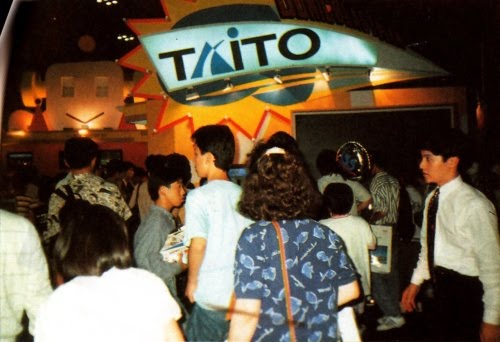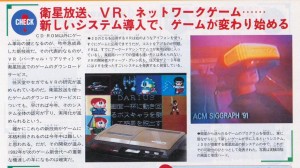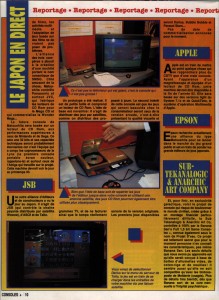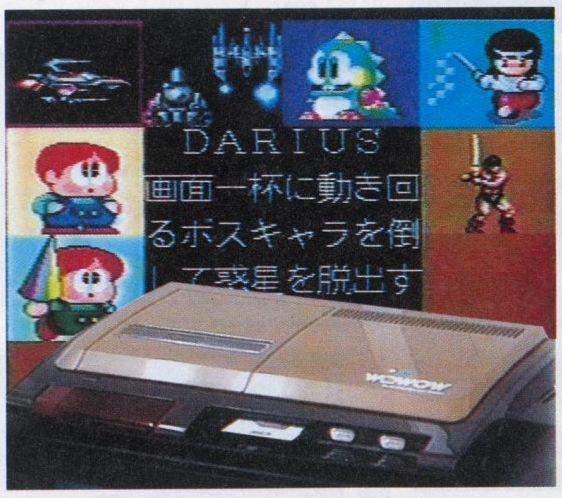A long time ago, Unseen64 was just a shell of itself. It was hosted on the notoriously bad Xoom.it hosting service, and looked pretty much like a 90’s website horribly made with Microsoft Frontpage. However, as old as Unseen64 looked back then (it was 2004!), it wasn’t the first site dedicated to unreleased games maintained by Italians. That particular accolade belongs to The Strange (and Rare) Videogame Pics Page, created by Fabrizio Pedrazzini, an Italian games journalist, known for his work at magazines such as the glorious ‘Super Console’. TS(&R)VPP, as the name says, wasn’t solely about beta games. There were pictures of pirated software, obscure and limited edition consoles, demos, and more. Hidden among those pages was the Taito/JSB/ASCII WOWOW console.
For years, the only available information on the Taito WOWOW was limited to this report from the 1992 Tokyo Toys Show, via French videogame magazine, ‘Console+‘:
Another alliance between publishers and manufacturers has been established in Japan. It’s about JSB (that controls the satellite channel Wowow), ASCII and Taito.
A prototype has been developed. It’s small and equipped with a CD-Rom player. The basic idea is innovative: it’s about distributing games via satellite, like the streaming of TV programs, and to charge only the time really spent to play.
The other interesting thing about the console is that the games that will be released to the public will be the same of the arcade versions, with the video and audio quality of the originals.
The first games available will be Darius, Bubble Bobble and Parasol Stars…
A released date has not been disclosed yet.

Taito’s booth at Tokyo Toy Show 1992 (picture courtesy of Hardcore Gaming 101 blog)
The interview with Yukiharu Sambe
We have been able to get in touch with the Research & Development manager of TAITO Corporation Mr. Yukiharu Sambe, Professional engineer at the time the Wowow was created, and he was kind enough to share some new information, previously unknown, about this unreleased console. Enjoy!
Note: original interview in english, without edits or corrections
Question: How did you start to work in the videogame industry? What did you do at Taito back then?
Yukiharu Sambe: I was electrical engineer and interested in the microcomputers in late 70’s. One day, I happen to see ‘Space Invaders’ video game at the arcade and it attract me much. After I joined Taito, I designed/managed many arcade hardware and game programs. I’m happy that you know Darius which I directed and managed hardware, game concept, software developments and so on.
Q: How the WOWOW project started? What was the idea behind it?
YS: Japanese administrator had a plan of data broadcasting. Meanwhile, I wanted to deliver games to home television set. And I happen to know, JSB is trying to combine CPU and memories on its satellite receiver. I talked to JSB and project started.

The only other known scan of the Wowow, thanks to Andro from the Assembler Forum, translated by @painapple9
Satellite transmissions, VR, Network Games,… With the arrival of new gaming systems, games begin to change. Other than the CD-ROM, what’s becoming the key to a revolution in gaming are new technologies, that enhanced quickly during the last year. This actual thing is VR and game download services via satellite transmission. Nintendo, Sega and others continue researching on VR.
As far as download services for games that use satellite transmission go, with the licenses of these systems possibly coming in as early as this year, implementation is making progress. Indeed one might think it’s difficult to make this new technology standard for games in the course of this year. Still, it is a fact that these developments are continuing and 1992 is becoming a crucial bridge building year for the next new generation of games.
For VR applying CG in 3D an AIFON (?) as seen on the right is used. Even though it looks like it could be applied to games instantly, reducing the costs is an issue. Regarding VR, so far Namco is part of a step to actual utilization with arcade systems and one can’t think of it’s appearance on home consoles as something far off. VR developer Steve Glenn is even claiming Nintendo was going to release an amazing game system taking advantage of VR 2-3 years later.
A system receiving game software sent via satellite, that let’s you obtain new games from home. It has been announced this was one of the capabilities of the new system proposed by JSB. The image shows a screen in experimental phase and of the reception-hardware.
Q: Why there was a partnership with the broadcaster JSB and ASCII corporation?
YS: JSB has their own satellite and its channel, ASCII has developing satellite data communication systems.
Q: Could you describe me in details your role in the WOWOW project?
YS: I was a manager of new technology R&D in TAITO at this time. I directed some of Taito young engineers and develop/designed this wowow game console, include hardware, sample game programs and menu selection programs.
Q: The console was based on some specific arcade hardware?
YS: I selected and modified arcade video game hardware because I used to it.
Q: How the satellite connection worked? How did you use the satellite: to download games, to stream games? How did you pay for the service?
YS: JSB satellite had not only video broadcasting channel but data stream channel also. Taito send date stream to JSB satellite base(which was located near Tokyo) through RJ45 connector and JSB transfer these stream to satellite. Home receiver detect these data flow and store it into receiver memory. If subscriber select game play, on memory game program will run. We responsible to the game delivery, JSB responsible to satellite communication and ASCII responsible data interfaces. We intended to collect the game subscriber fee through JSB.
Q: What games were planned for the console? Were there mostly arcade ports?
YS: We have to think about the game memory size. Small size was best and I planned to use some early 80’s arcade games (they are small size). As a demonstration and presentation game, we modified and minimized the game ‘Darius’.
Q: Were there any exclusive games designed for the console?
YS: We modified the ‘Darius’ only as a game. We developed menu selection software which had original graphics and sound also.
Q: Why the project was cancelled? Too much competition? Technical problems? The satellite technology was not good enough?
YS: We had two reasons to suspend this project. One: Data transferring speed was not enough and many error correction packets eat up these precious data speed. User should wait more than several minutes to download one small game. And if we try to broadcast several games at the same time, the download time needs more time. Second: At the beginning, JSB intended to combine game hardware in the home satellite receiver. However, memory was expensive and all combined receiver made the cost estimation very high. 5 years later, Nintendo absorbed satellite music company ‘St.GIGA’ and started their satellite download business in 1995. The data stream was almost same structure that we designed. Nintendo use their game console with special satellite game equipment, however, Nintendo did not make good success on this business. They had similar difficulties that we encountered before.
Q: When the console was canned, it was on early stage of development of it was almost completed?
YS: Project was suspended at the early stage. We made presentation and demonstration for newspapers, administrate people and so on. The demo was good, however it was difficult to plan good future satellite game business and I decided to suspend it. However/fortunately, these experiences made me to found new entertainment business ‘telecommunication Karaoke’ (in Japanese tuushin-karaoke X2000 in 1992) and it was successful. I found home karaoke business X-55/mediabox in 1995 through analog telephone line and distributed games to home, also. Every experience are precious.
Q: Are there any others existing images/videos about the console (maybe a press release kit, planned advertisement, magazine’s articles)? Is a working console still existing somewhere in Taito’s headquarter?
YS: Unfortunately, I have no pictures and sample console, also.
Thanks a lot to Yukiharu Sambe for his time
What do you think about this unseen game? Give your vote!
Would you like to add more info, screens or videos to this page? Add a comment below!
- Hasbro Toaster VR [Cancelled 1992 Virtual Reality Console] - 04-10-2018
- Zone of the Enders 3 (Enders Project) [Cancelled – PS3, Xbox 360] - 28-03-2018
- Lisa: The Painful RPG [Beta – PC] - 16-03-2018





Really interesting! Just when I thought I knew every defunct console out there… I bet if the prototype WOWOW still exists, it would be worth quite a bit to a collector at auction!
I wonder if someone at Taito could still have a prototype hardware, they seem the kind of company that would preserve their history
I can only echo James J’s comments…just WOW.
I know to many obscure hardware and lost games make for very dull/boring reading, but i’d much rather read up on something like this, which i had absolutely no idea even existed until now, rather than the latest mega-hyped game of the current generation.
This one came from nowwhere as likes of Edge, RetroGamer and Gamestm covered obscure hardware many times over the years and i cannot recal hearing anything about this, unless my age/memory are playing tricks.
Really appreciate this being shared.
Damiano did a great work, in the future he will have another article about another of the most obscure, unreleased consoles :)
Great piece! I didn’t know that such a thing existed! Reminds me of the Satellaview that Nintendo did in the 90s.
Indeed, it seems that Satellite-powered game consoles were the hip thing to develop in the ’90 ;)
Here are some videos (where two games were shown: Space Invaders and Puzzle Bobble) and links regarding the Taito X55 Karaoke mentioned in the article:
https://www.youtube.com/watch?v=-pCQcRxqyDg
https://www.youtube.com/watch?v=R8HZ7iEQVLo
https://www.youtube.com/watch?v=qG3Qzdgjw6c
https://ja.wikipedia.org/wiki/X-55
Translated in English: https://translate.google.com/translate?sl=ja&tl=en&js=y&prev=_t&hl=en&ie=UTF-8&u=https%3A%2F%2Fja.wikipedia.org%2Fwiki%2FX-55&edit-text=
http://www.briconsola.com/reportajes-consolas/taito-x55/
Thanks a lot for the videos and links Fabrizio, it’s super appreciated :)
The mighty JAPJAC has published the first ever pictures and title names for some of Taito’s lost downloadable games for the first time ever on-line, in any language. Includes never seen or reported on before; two unique Bubble Bobble instalments and a unique Tetris:
https://youtu.be/5-O2PAUTt6A
https://youtu.be/OkdH18I5ZL8
Enjoy.